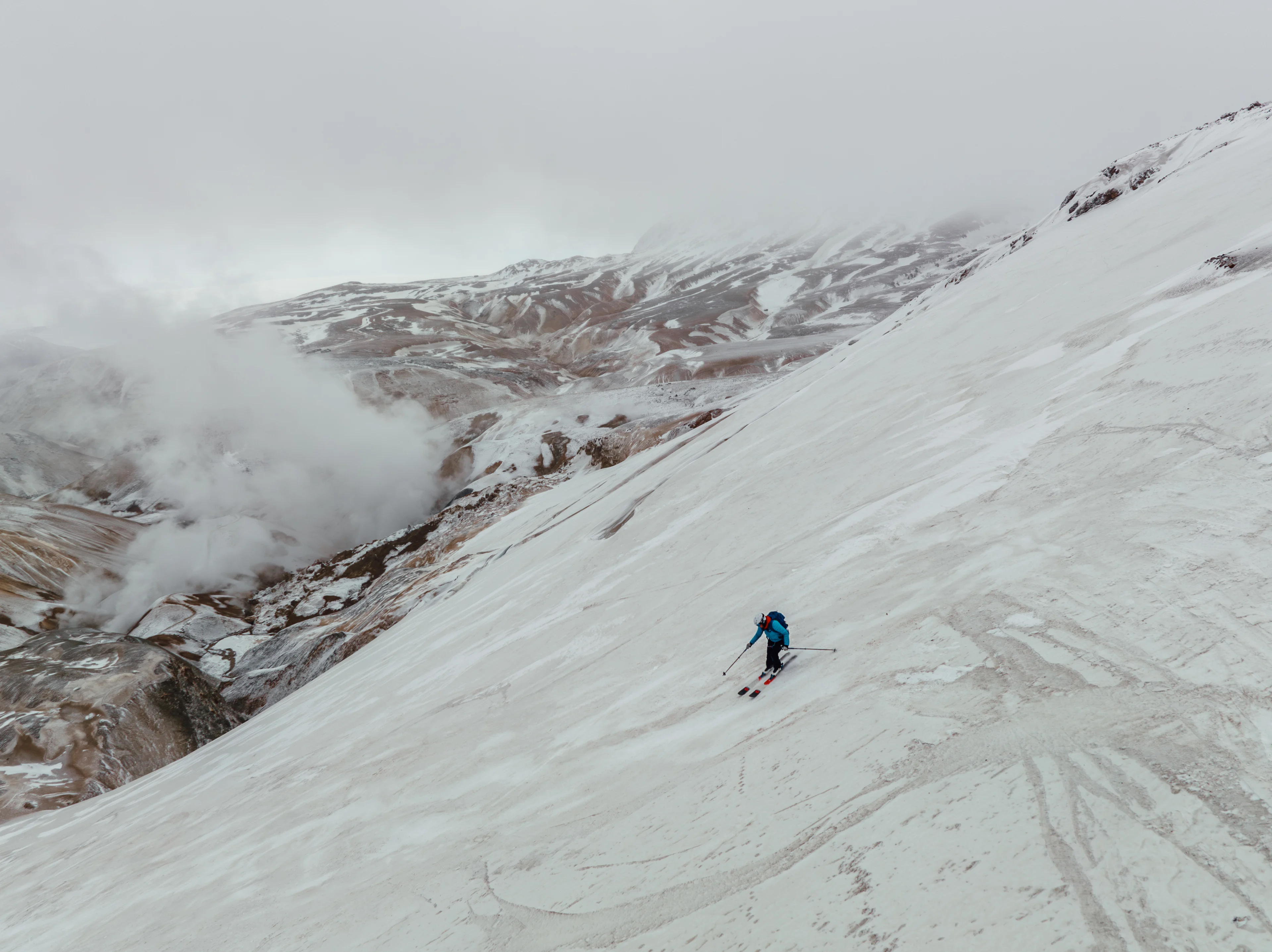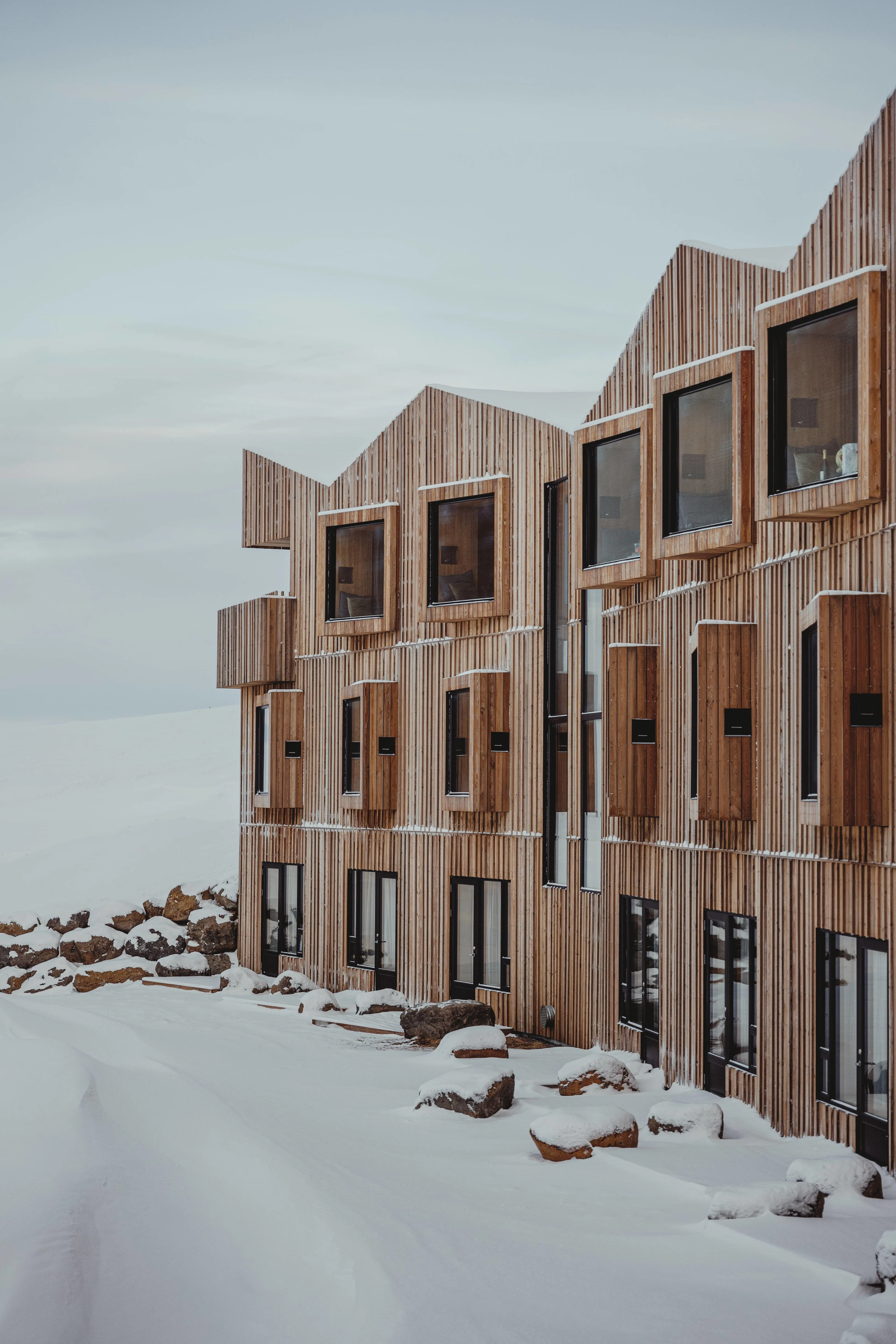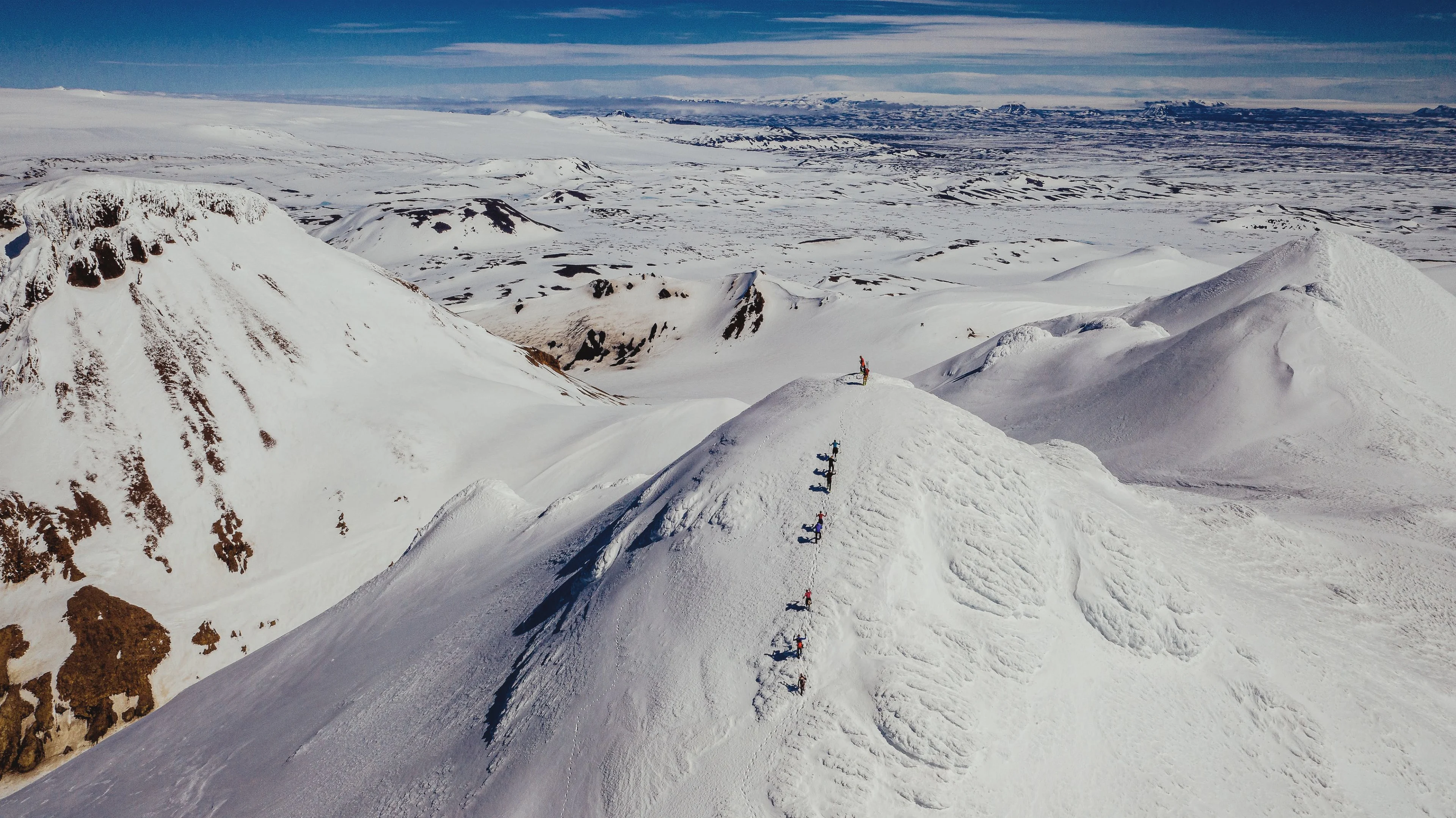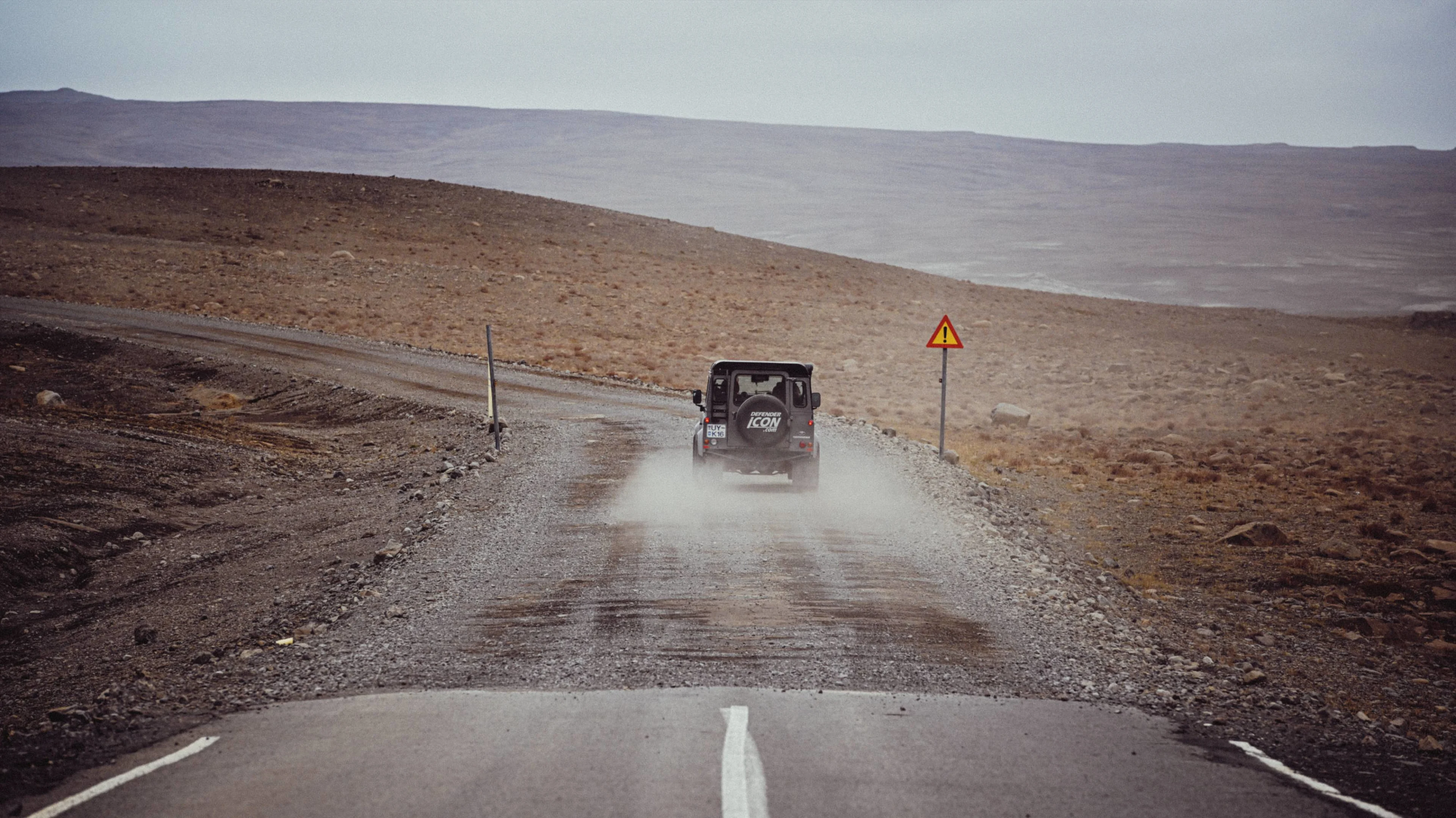Your comprehensive guide to skiing in Kerlingarfjöll
Located in the heart of Iceland’s rugged interior, Kerlingarfjöll stands as a testament to the raw, untamed beauty that defines this island nation. Known for its steaming geothermal valleys and towering snow-capped peaks, this protected nature reserve offers a rare skiing experience. In this comprehensive guide, we delve into everything you need to know about skiing in Kerlingarfjöll, from its storied history to the practicalities of gearing up for an unforgettable adventure. Whether you’re a seasoned skier looking for your next challenge or a newcomer eager to explore the untamed slopes, Kerlingarfjöll promises an experience that’s as exhilarating as it is unique.

The allure of Kerlingarfjöll
Kerlingarfjöll’s allure lies not just in its pristine snowscapes and breathtaking landscapes, but also in the unique opportunity it offers to ski towards and around the Hveradalir geothermal. Kerlingarfjöll is distinguished as one of only two places on the planet where adventurers can ski amidst the steam of hot springs, fumaroles, and boiling mud pots. The other? The famous Japanese resorts that also offer geothermal skiing, such as those in Hakuba Valley or Niseko.
This blend of ice and heat adds a mesmerizing dimension to the skiing experience in Kerlingarfjöll. As skiers carve through the snow, they are not only treated to stunning views of frosty peaks but also the enchanting sight of steam clouds rising from the earth, a testament to the planet’s raw power and geothermal activity, especially pronounced in the magical landscape of Hveradalir.
A brief history of skiing in Kerlingarfjöll
For centuries, Kerlingarfjöll was a wild and untouched region. It wasn’t until the 1930s when Guðmundur Einarsson, a trailblazing naturalist and businessman, began offering mountaineering courses in this secluded area. Motivated by Einarsson’s initiative, the Iceland Touring Association (Ferðafélag Íslands) started organizing guided hikes in Kerlingarfjöll, and even built a cabin there in 1937.
In July 1961, a pioneering ski course was held in the area with around 30 participants making the 8-hour journey from Reykjavik, crossing five rivers along the way. The cost of the tour, which included both transport and lodging, was set at ISK 800. Due to the small kitchen size, guests were served breakfast in bed. The skiing experience was highly praised by participants, and even compared to that of the Alps. This led to the establishment of a summer ski school that, from June through August each year, attracted thousands of Iceland’s youth, eager to learn how to ski. The school thrived for many years, occupying a cherished place in the hearts of Icelanders. However, the eruption of Hekla volcano on August 17, 1980, marked a significant moment for the school. The eruption filled the sky with ash, turning daylight to darkness and coating the mountains with a layer of ash – almost like black snow. Despite the challenging conditions, the ski school staff diligently cleared the slopes for a group of teenagers arriving shortly after. This event is often seen as a pivotal moment for the ski school, which eventually closed as the snow on the mountains receded over the years. Today, Kerlingarfjöll is experiencing a renaissance as new generations seek to explore its slopes.

A skier’s paradise: Geographical and climate overview
Kerlingarfjöll spans approximately 150 square kilometers, offering a dramatic landscape characterized by snow-capped summits, steaming hot springs, and the vibrant hues of rhyolite mountains. The area’s geography is marked by its diversity, from vast glaciers that sculpt the land to the geothermal areas that dot the terrain. Mineral-rich waters paint the valleys in a palette of reds, yellows, and greens.
The climate in Kerlingarfjöll is as variable as its landscape. Due to its elevation and proximity to the Arctic Circle, the area experiences cool temperatures year-round, with summer bringing milder weather that allows for hiking and exploration. Winters are cold and intense with heavy snowfall transforming the region into a snowy wonderland that, when calm, can be ideal for skiing and snowshoeing. This climatic variation, combined with the geographical features, makes Kerlingarfjöll a unique skiing destination for adventurers looking for challenging trails and hypnotic scenery in Iceland’s untouched wilderness.
The ski season in Kerlingarfjöll typically runs from late November to early May, depending on the snow conditions. The best time for skiing is between February and April, when the snow is most reliable, and the daylight hours begin to extend, offering more time on the slopes. During this period, the weather is still variable, so skiers should be prepared for everything from clear, sunny days to snowy conditions that can change rapidly.
Backcountry and cross-country skiing in Kerlingarfjöll
Kerlingarfjöll is a haven for both cross-country and backcountry skiing, offering trails that match a variety of skill levels. The absence of ski lifts means that skiers are treated to an authentic and unspoiled experience. The untamed landscape is perfect for those seeking adrenaline-fueled ski journeys beyond the groomed trails of conventional resorts. The sense of solitude and connection with nature is unparalleled, offering a truly immersive wilderness experience.
Both types of skiing in Kerlingarfjöll allow visitors to experience the raw beauty of Iceland’s winter landscapes. As new trails are developed and amenities improved, the focus remains on preserving the unique character of Kerlingarfjöll and ensuring it will remain a premier destination for skiing enthusiasts.

Highland hospitality: Where to stay in Kerlingarfjöll
In terms of accommodation, Kerlingarfjöll is home to Highland Base. Located in the Ásgarður Valley, this destination is a remote hospitality outpost encompassing private lodges, a hotel, huts, a riverside campground, and a dining venue serving bistro-style comfort food, along with geothermal baths. Adding to the allure is the vibrant après-ski scene, where guests can unwind and share tales of their day’s exploits on the slopes over warm drinks and cozy gatherings. This oasis of warmth and nourishment is a year-round staging ground for highland adventures, offering the perfect blend of thrilling outdoor activities and soothing relaxation.

Guided ski tours and activities
Exploring Kerlingarfjöll’s majestic slopes through skiing tours has become an essential experience for winter sports enthusiasts. Highland Base offers a range of guided tours that cater to all skill levels, ensuring a safe and unforgettable Iceland ski holiday. For beginners, there’s a Backcountry ski course that covers the basics in an 8-hour, fun-filled day, teaching the dos and don’ts of skiing in untouched snow. Those interested in Nordic skiing can embark on a 6-hour course that emulates the style of early polar explorers, covering a distance of 5 km. More experienced adventurers might prefer the Scenic Nordic ski tour, a 5-hour expedition around the mountains and the iconic Loðmundur mountain, spanning 12 km. Alternatively, the Hot spring ski tour offers a unique 4-hour journey around hot springs, covering 7 km through stunning views. All tours provide a remarkable way to experience the breathtaking landscapes of Kerlingarfjöll.
You should also explore the Highland Base activity calendar, which is a great resource for planning your adventure.

Getting there: Journey to the highlands
Getting to Kerlingarfjöll requires some planning, as it involves traversing so-called F-roads. These roads are unpaved and often challenging to navigate. A robust, fully insured vehicle is mandatory during summer, while winter demands more specialized transport. We provide reliable transfers to and from the highlands, offering professionally driven super jeep journeys that transform the winter trip into its own heart-pounding adventure.
There are no rental facilities at Kerlingarfjöll, so skiers must come prepared. Essential items include:
Skiing equipment: Skis, poles, and boots. Ensure your gear is suitable for backcountry conditions.
Safety gear: Avalanche transceiver, probe, and shovel are crucial, even if you stick to the less demanding trails.
Warm clothing: Layering is key in Iceland’s unpredictable climate. Waterproof and windproof outer layers are essential. Do not wear inner layers made of cotton – opt for wool when you can. Jeans are not suitable.
Navigation tools: A charged smartphone with GPS capabilities, physical maps, and compasses can be invaluable in unfamiliar terrain.
Food and water: Pack high-energy snacks and enough water for your journey, as there are no facilities on the slopes.

Safety and precautions
Safety should always be a top priority when skiing in backcountry areas like Kerlingarfjöll. Conditions can change rapidly, so it’s essential to:
Always check the weather forecast before heading out. Be prepared for sudden changes in weather and visibility – even if the forecast looks stable.
Inform someone of your plans: Always let someone know where you’re going and when you expect to return.
Be avalanche aware: Familiarize yourself with avalanche safety practices and consider carrying an avalanche airbag pack.
Environmental considerations
Kerlingarfjöll’s stunning landscapes are a delicate ecosystem that demands respect and preservation. Skiers and visitors are urged to follow the principles of Leave No Trace, minimizing their impact on the natural environment. This includes:
Staying on designated trails to prevent erosion.
Packing out all trash, leaving the area as pristine as you found it.
Being mindful of wildlife and maintaining a safe distance.
These practices ensure that the beauty of Kerlingarfjöll remains intact for future generations to enjoy.
This Icelandic ski destination continues to attract those who seek the extraordinary, making it a must-visit for anyone passionate about skiing in Iceland.







